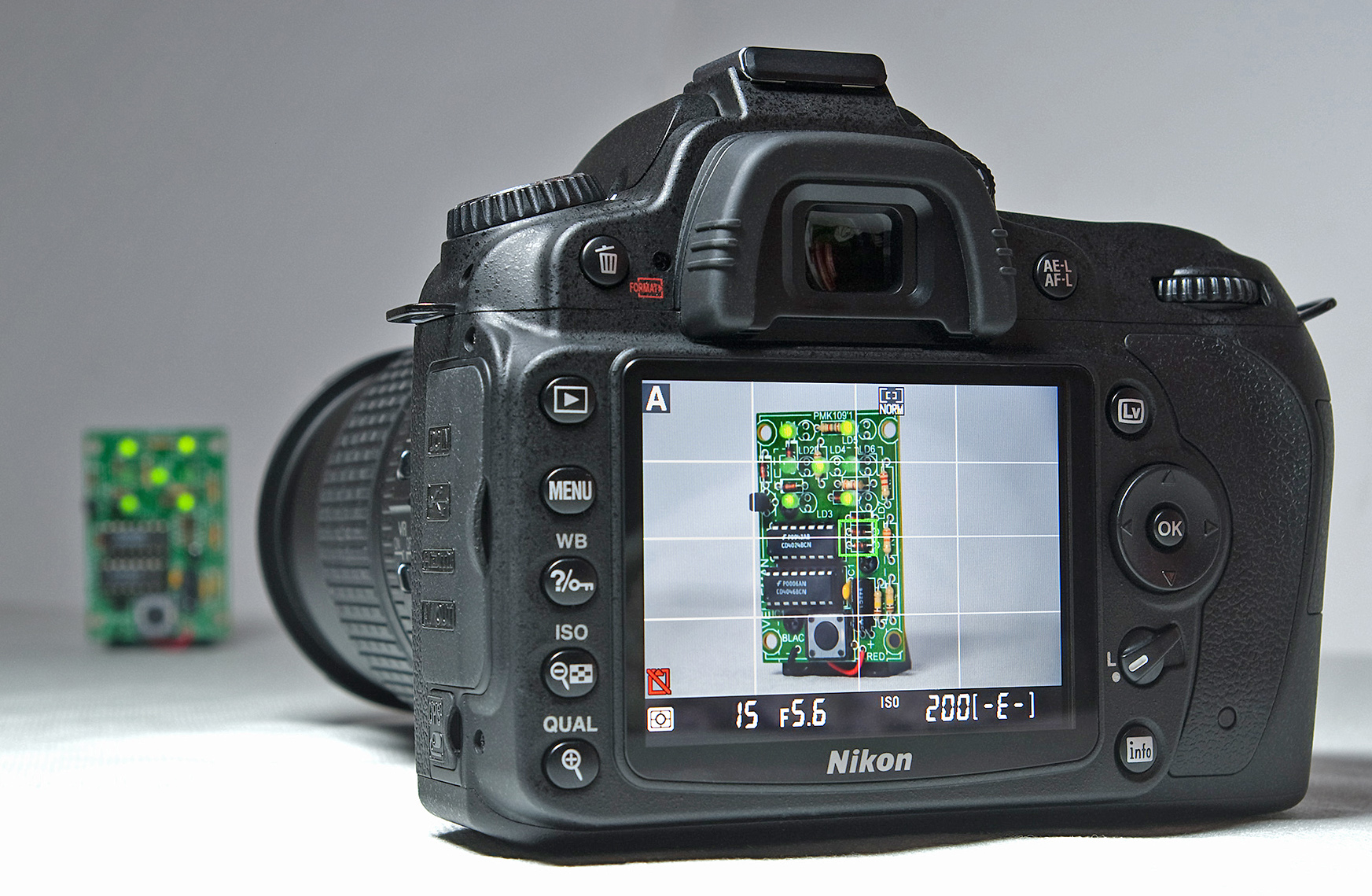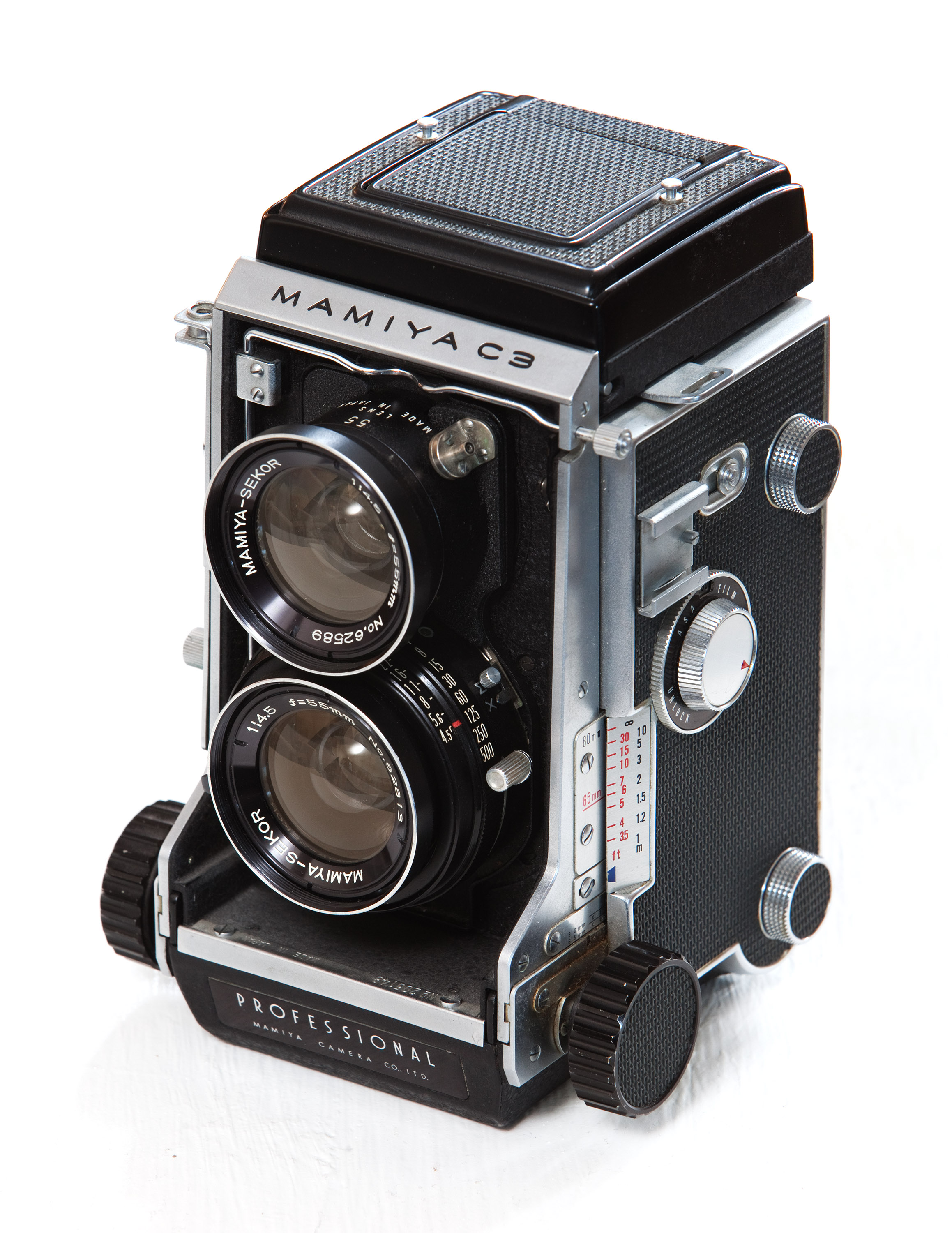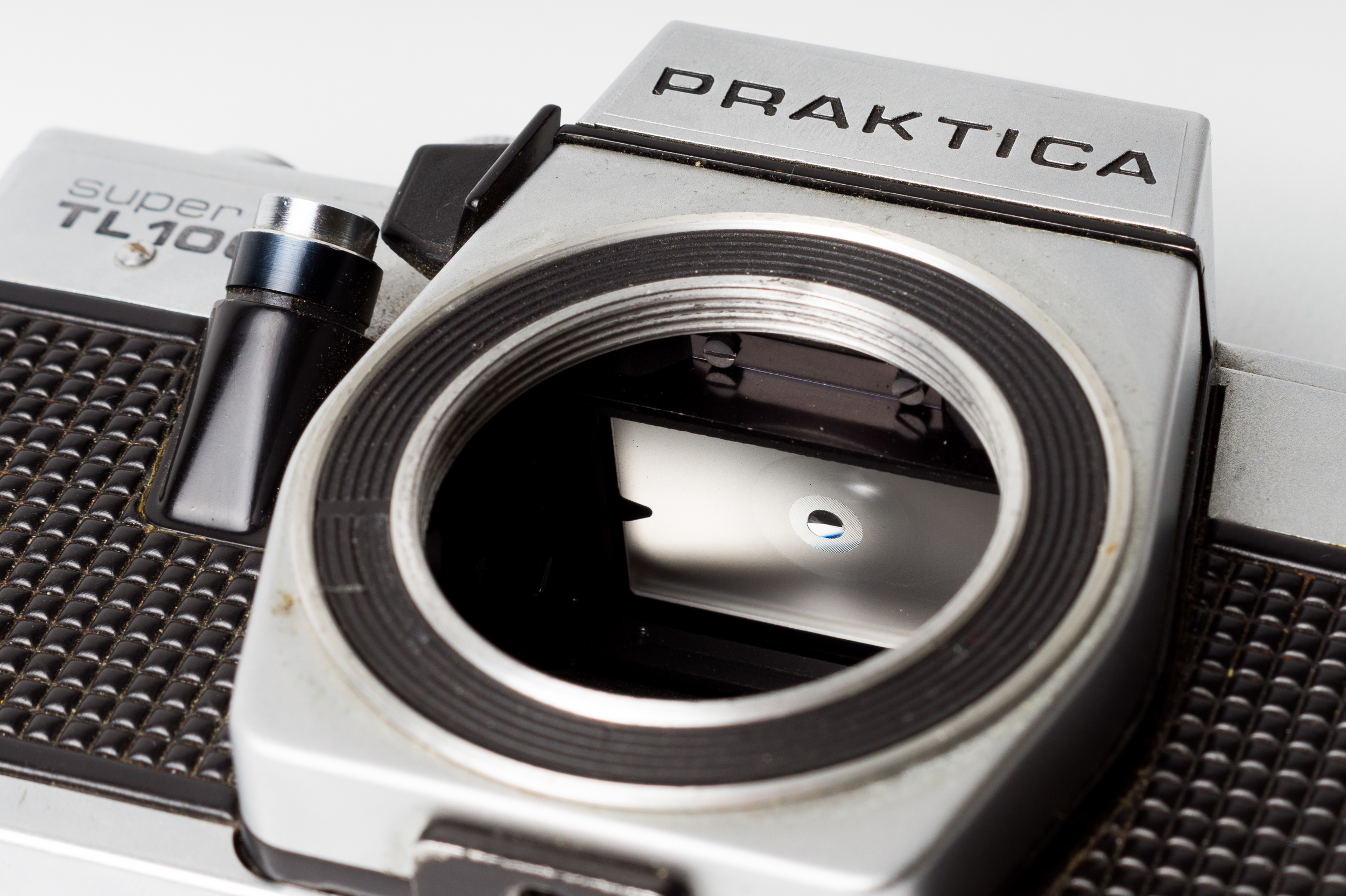|
Waist-level Finder
The waist-level finder (WLF), also called waist-level viewfinder (WLVF), is a type of viewfinder that can be used on twin lens and single lens reflex cameras. While it is typically found on older medium format cameras, some newer and/or 35 mm cameras have this type of finder (perhaps as an option). In the reflex camera, the light from the lens is projected onto a focusing screen. The waist-level finder makes this screen viewable from above, where the image is seen upright but reversed left-to-right. This allows the camera user to determine the target area while holding the camera below eye level. The eye-level finder is an evolution of the waist-level finder, using a roof pentaprism or pentamirror to correct the image while making it viewable through an eyepiece at the rear of the camera. Some digital cameras have an articulating screen or a swivel lens, this allows the screen to be angled to make it viewable at waist-level. With live preview the screen can be used as a viewfi ... [...More Info...] [...Related Items...] OR: [Wikipedia] [Google] [Baidu] |
Hasselblad Waist-level Viewfinder
Victor Hasselblad AB is a Swedish manufacturer of medium format cameras, photographic equipment and image scanners based in Gothenburg, Sweden. The company originally became known for its classic analog medium-format cameras that used a waist-level viewfinder. Perhaps the most famous use of the Hasselblad camera was during the Apollo program missions when the first humans landed on the Moon. Almost all of the still photographs taken during these missions used modified Hasselblad cameras. In 2016, Hasselblad introduced the world's first digital compact mirrorless medium-format camera, the X1D-50c, changing the portability of medium-format photography. Hasselblad produces about 10,000 cameras a year from a small three-storey building. Company history The company was established in 1841 in Gothenburg, Sweden, by Fritz Wiktor Hasselblad, as a trading company, F. W. Hasselblad and Co. The founder's son, Arvid Viktor Hasselblad, was interested in photography and started the phot ... [...More Info...] [...Related Items...] OR: [Wikipedia] [Google] [Baidu] |
Pentamirror
A pentamirror is an optical device used in the viewfinder systems of various single-lens reflex cameras instead of the pentaprism. It is used to reverse again the laterally reversed image coming from the reflex mirror. Instead of the solid block of glass of the prism in pentaprism system, here 3 mirrors are used to perform the same task. This is cheaper and lighter, but generally produces a viewfinder image of lower quality and brightness. This optical device is often (more precisely) referred to as ''roof pentamirror'' because of the roof-like ridge.Paul R. Yoder. ''Opto-Mechanical Systems Design'', 2005page 435 See also *Pentaprism A pentaprism is a five-sided reflecting prism used to deviate a beam of light by a constant 90°, even if the entry beam is not at 90° to the prism. The beam reflects inside the prism ''twice'', allowing the transmission of an image through a r ... * Single-lens reflex camera Notes External linksUnderstanding Viewfinders [...More Info...] [...Related Items...] OR: [Wikipedia] [Google] [Baidu] |
Motion Blur
Motion blur is the apparent streaking of moving objects in a photograph or a sequence of frames, such as a film or animation. It results when the image being recorded changes during the recording of a single exposure, due to rapid movement or long exposure. Usages / Effects of motion blur Photography When a camera creates an image, that image does not represent a single instant of time. Because of technological constraints or artistic requirements, the image may represent the scene over a period of time. Most often this exposure time is brief enough that the image captured by the camera appears to capture an instantaneous moment, but this is not always so, and a fast moving object or a longer exposure time may result in blurring artifacts which make this apparent. As objects in a scene move, an image of that scene must represent an integration of all positions of those objects, as well as the camera's viewpoint, over the period of exposure determined by the shutter speed. In ... [...More Info...] [...Related Items...] OR: [Wikipedia] [Google] [Baidu] |
Candid Photography
A candid photograph is a photograph captured without creating a posed appearance. The candid nature of a photograph is unrelated to the subject's knowledge about or consent to the fact that photographs are being taken, and are unrelated to the subject's permission for further usage and distribution. The crucial factor is the actual absence of posing. However, if the subject is absolutely unaware of being photographed and does not even expect it, then such photography is secret photography, which is a special case of candid photography. As an art form The person who is generally credited with being the first available light "candid" photographer is Dr. Erich Salomon who photographed the social elite in Berlin, Germany and politicians and diplomats during the late 1920s and early 1930s with a 1 3/4 x 2 1/4 glass plate or cut, sheet, film camera called the Ermanox, fitted with an f/1.8 Ernostar lens. The Ermanox was introduced by the Ernemann-Werke (Works) of Dresden, Germany, in ... [...More Info...] [...Related Items...] OR: [Wikipedia] [Google] [Baidu] |
Street Photography
Street photography (also sometimes called candid photography) is photography conducted for art or enquiry that features unmediated chance encounters and random incidents within public places. Although there is a difference between street and candid photography, it is usually subtle with most street photography being candid in nature and some candid photography being classifiable as street photography. Street photography does not necessitate the presence of a street or even the urban environment. Though people usually feature directly, street photography might be absent of people and can be of an object or environment where the image projects a decidedly human character in facsimile or aesthetic.Colin Westerbeck. ''Bystander: A History of Street Photography''. 1st ed. Little, Brown and Company, 1994. The street photographer can be seen as an extension of the '' flâneur'', an observer of the streets (who was often a writer or artist). Framing and timing can be key aspects of the ... [...More Info...] [...Related Items...] OR: [Wikipedia] [Google] [Baidu] |
Live Preview
Live preview is a feature that allows a digital camera's display screen to be used as a viewfinder. This provides a means of previewing framing and other exposure before taking the photograph. In most such cameras, the preview is generated by means of continuously and directly projecting the image formed by the lens onto the main image sensor. This in turn feeds the electronic screen with the live preview image. The electronic screen can be either a liquid crystal display (LCD) or an electronic viewfinder (EVF). Background The concept for cameras with live preview largely derives from electronic (video) TV cameras. Until 1995 most digital cameras did not have live preview, and it was more than ten years after this that the higher end digital single-lens reflex cameras (DSLR) adopted this feature, as it is fundamentally incompatible with the swinging-mirror single-lens reflex mechanism. The first digital still camera with an LCD for autogain framing live preview was the ... [...More Info...] [...Related Items...] OR: [Wikipedia] [Google] [Baidu] |
Swivel Lens
A swivel lens is a lens that freely rotates while attached to a camera body. They are used on some compact digital and video cameras (camcorders). These lenses make it easy for a photographer to aim a camera without moving around too much. Swivel lenses come in different sizes and shapes. A swivel lens is also known as a swiveling lens, swivelling lens, and rotating lens. In contrast, swivel LCDs (also known as articulating screen) are displays that freely rotate while attached to a camera body. Usually, the camera body is much larger than the swivelling display. Swivel LCD devices can be considered as swivel lens devices because the camera body can swivel around the small display; albeit, aiming the camera is more difficult. Most camcorders have a swivel LCD. Uses * Enables the user to take pictures from unique perspectives and camera angles * Easy composition of images without the need to bend, crouch, or move around * Shooting self-portraits * Shooting candid photos List of ... [...More Info...] [...Related Items...] OR: [Wikipedia] [Google] [Baidu] |
Articulating Screen
An articulating screen is a built-in small electronic visual display which is not fixed, but rather can be repositioned using a hinge or pivot. The articulating screen is known under different other names such as flip-out screen, flip screen, adjustable screen, articulated screen, or hinged screen. According to the way it moves, there are four main types: #The display moves around one axis, so that it only tilts. It is called ''tilting screen'' or ''tiltable screen''. #The display tilts horizontally both up and down and also vertically. This type is called ''double-hinged tilting screen'', ''two-axis tilting screen'', ''three-direction tilting screen'' or ''screen with 3-way tilt''. #The display moves around two axes which are at a right angle to each other, so that the screen both tilts and swivels. This type is called ''swivel screen''. Other names for this type are ''vari-angle screen'', ''fully articulated screen'', ''fully articulating screen'', ''rotating screen'', ''multi-an ... [...More Info...] [...Related Items...] OR: [Wikipedia] [Google] [Baidu] |
Pentaprism
A pentaprism is a five-sided reflecting prism used to deviate a beam of light by a constant 90°, even if the entry beam is not at 90° to the prism. The beam reflects inside the prism ''twice'', allowing the transmission of an image through a right angle without inverting it (that is, without changing the image's handedness) as an ordinary right-angle prism or mirror would. The reflections inside the prism are not caused by total internal reflection, since the beams are incident at an angle less than the critical angle (the minimum angle for total internal reflection). Instead, the two faces are coated to provide mirror surfaces. The two opposite transmitting faces are often coated with an antireflection coating to reduce spurious reflections. The fifth face of the prism is not used optically but truncates what would otherwise be an awkward angle joining the two mirrored faces. In cameras A variant of this prism is the roof pentaprism which is commonly used in the viewfinder ... [...More Info...] [...Related Items...] OR: [Wikipedia] [Google] [Baidu] |
Mamiya 645 1000s Waist Level Finder
is a Japanese company that manufactures high-end cameras and other related photographic and optical equipment. With headquarters in Tokyo, it has two manufacturing plants and a workforce of over 200 people. The company was founded in May 1940 by camera designer Seiichi Mamiya () and financial backer Tsunejiro Sugawara. History Mamiya originally achieved fame for its professional medium-format film cameras such as the Mamiya Six and the Mamiya Press series. It later developed the industry workhorse RB67 series, the RZ67, the 645 and the twin-lens reflex Mamiya C-series, used by advanced amateur and professional photographers. Many Mamiya models over the past six decades have become collectors' items. The earliest Mamiya Six medium-format folding camera, the 35 mm Mamiya-Sekor 1000DTL, the lightweight 35 mm Mamiya NC1000, the 6×6 cm medium-format C series of interchangeable-lens twin-lens reflex (TLR) cameras, and the press cameras of the Super/Universal series ... [...More Info...] [...Related Items...] OR: [Wikipedia] [Google] [Baidu] |
Focusing Screen
A focusing screen is a flat translucent material, either a ground glass or Fresnel lens, found in a system camera that allows the user of the camera to preview the framed image in a viewfinder. Often, focusing screens are available in variants with different etched markings for various purposes. For instance, "overall matte" focusing screens with no etchings are a popular choice for astrophotography and other low-light situations. Overview The history of the focusing screen is almost as long as the history of the camera. Some primitive cameras consisted of a box with a board holding the lens in the front and a focusing screen in the back that was replaced by the imaging medium (plate, film holder) before taking the picture. The most common type of focusing screen in non-autofocus 35 mm SLR cameras is the split screen and microprism ring variation that aids focusing and became standard in the 1980s. The microprism ring breaks up the image unless the lens setting is in focu ... [...More Info...] [...Related Items...] OR: [Wikipedia] [Google] [Baidu] |
135 Film
135 film, more popularly referred to as 35 mm film or 35 mm, is a format of photographic film used for still photography. It is a film with a film gauge of loaded into a standardized type of magazine – also referred to as a cassette or cartridge – for use in 135 film cameras. The engineering standard for this film is controlled by ISO 1007 titled '135-size film and magazine'. The term 135 was introduced by Kodak in 1934 as a designation for 35 mm film specifically for still photography, perforated with Kodak Standard perforations. It quickly grew in popularity, surpassing 120 film by the late 1960s to become the most popular photographic film size. Despite competition from formats such as 828, 126, 110, and APS, it remains the most popular film size today. The size of the 135 film frame with its aspect ratio of 1:1.50 has been adopted by many high-end digital single-lens reflex and digital mirrorless cameras, commonly referred to as " full frame". Eve ... [...More Info...] [...Related Items...] OR: [Wikipedia] [Google] [Baidu] |










